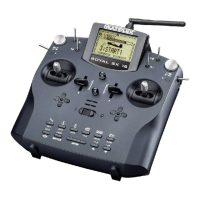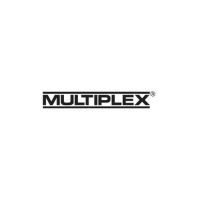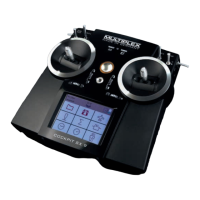Do you have a question about the Multiplex Royal Evo and is the answer not in the manual?
| Type | Transmitter |
|---|---|
| Channels | 12 |
| Modulation | PPM, PCM |
| Display | LCD |
| Battery Type | NiMH |
| Battery Capacity | 2000 mAh |
Crucial instruction to read safety notes carefully before use.
Highlights hazards associated with RC models and user responsibility.
Guidelines for safe installation of control surfaces and linkages.
Advice on protecting electronic components from vibration and damage.
Best practices for handling and securing cables.
Essential checks before flying, including channel availability and system function.
Advice for safe operation, including pilot experience and site selection.
Warning about static discharge and recommended countermeasures.
Describes the controls and displays on the front of the transmitter.
Details the rear panel features like handles and connectors.
Instructions on how to open and close the transmitter casing.
Monitors transmitter battery charge status during operation and charging.
Crucial safety information regarding the transmitter battery and charging.
Detailed instructions on how to charge the transmitter battery correctly.
Guidelines for proper maintenance and storage of the transmitter battery.
Initial setup for language selection and transmitter power-on.
Explains the power-on information screen and RF module status.
Safety check for throttle position upon power-on.
Safety check for RF signal activation with synthesizer modules.
Shows digi-adjustor, model memory, voltage, version, and trims.
Shows digi-adjustor, model memory, voltage, flight mode switch.
Displays timers with assigned switches and trim positions.
Shows transmitter variant, software, RF module, battery status.
Explains the function of the keypad buttons for menu access and operation.
How digi-adjustors are used for programming and navigation.
Assigning parameters to digi-adjustors for in-flight adjustments.
How to access the main menus using direct access buttons.
Explains the "Centre Trim" principle and its advantages.
Highlights benefits like stored settings and flight phase trims.
Introduces model templates for fixed-wing and helicopters.
Guides the user through creating a new model for fixed-wing aircraft, covering memory, template, and controls.
Guides helicopter model creation: template selection, servo config, control mode, assignments.
Details the BASIC template for simple power models.
Lists transmitter controls assigned for the ACRO template.
Shows servo connections for the ACRO template.
Fine-tuning adjustments for the ACRO template.
Lists transmitter controls assigned for the HOTLINER template.
Shows servo connections for the HOTLINER template.
Fine-tuning adjustments for the HOTLINER template.
Lists transmitter controls assigned for the DELTA template.
Shows servo connections for the DELTA template.
Fine-tuning adjustments for the DELTA template.
Lists transmitter controls assigned for the GLIDER template.
Shows servo connections for the GLIDER template.
Fine-tuning adjustments for the GLIDER template.
Lists transmitter controls assigned for the 4-Flaps template.
Shows servo connections for the 4-Flaps template.
Fine-tuning adjustments for the 4-Flaps template.
Lists transmitter controls assigned for the HELImech template.
Shows servo connections for the HELImech template.
Fine-tuning adjustments for the HELImech template.
Lists transmitter controls assigned for the HELIccpm template.
Shows servo connections for the HELIccpm template.
Fine-tuning adjustments for the HELIccpm template.
Configures global transmitter settings like trim display, sounds, and battery alarm.
Explains the concept and application of freely definable mixers.
Steps to define custom mixers by assigning inputs and options.
Defines transmitter controls used for servo operation.
Defines physical controls used for switching functions.
Method for assigning controls to functions using Quick-Select.
Lists available switch functions like DR, CombiSwitch, Throttle-cut.
Explains teacher/pupil control modes and capabilities.
Details connecting and setting up the ROYALevo as a teacher unit.
Functionality and usage of the PIN for transmitter protection.
How to select the display language and install new ones.
Setting a custom name for the transmitter display.
Configures settings related to transmitter control switches.
Details parameters for individual transmitter controls.
Couples aileron and rudder for smoother turns.
Adjusts aileron deflection to reduce adverse yaw.
Gyro system intended for longitudinal axis stabilization.
Gyro system intended for vertical axis (yaw) stabilization.
Adjusts throttle for yaw control commands.
Adjusts throttle for roll control commands.
Adjusts throttle for pitch control commands.
Adjusts servo travels, centres, and intermediate points.
Sets servo reverse direction and neutral trim.
Adjusts servo calibration points for travel and symmetry.
Details the MULTInaut IV function for controlling loads and servos.
Lists available transmitter controls/mixers for fixed-wing models.
Lists available controls/mixers for helicopter models.
Lists available transmitter controls/mixers for fixed-wing models.
Lists available controls/mixers for helicopter models.
Records operating time for each model memory.
Timer that starts with a switch but can only be stopped after the slot time.
Cumulative timer that sums operating times.
Timer that runs backward from a set alarm time.
Lists and allows selection of different model memories.
Process for copying model data between memories.
Procedure for erasing model memories.
Manages up to four flight phases per model.
Adds scanning capability for frequencies/channels.
Function to scan the entire band for detected signals.
Checks if the selected channel is occupied at power-on.
Instructions for installing the scanner module.
Checks channel occupation for HFM-4 module models.
Backing up data and updating software via PC.
Connecting the transmitter to a PC for flight simulators.











